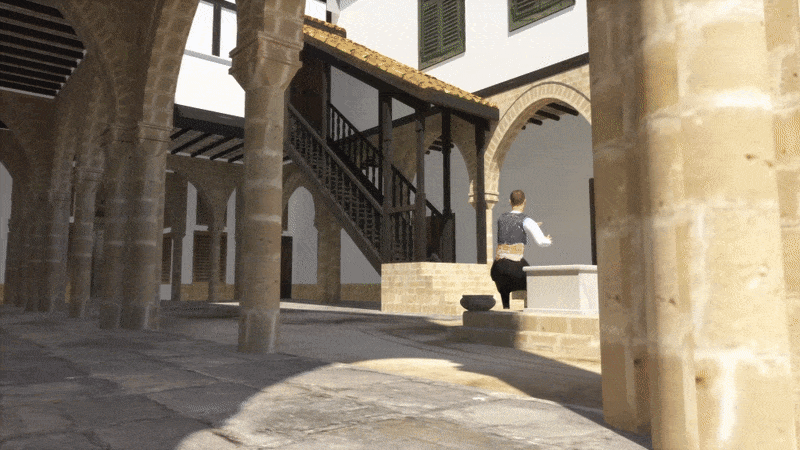Virtual Dance Museum: the case of Cypriot folk dancing
Project Description

Cyprus, as an island in the crossroad of three continents, is rich in history and cultural heritage, while its tradition has been transmitted-to and influenced-by various neighboring civilizations. Over the last decade, and due to the recent technological advances, there is a significant tendency to digitize, document, preserve, and protect tangible cultural heritage creations. However, apart from tangible artifacts, cultural heritage also encompasses a range of important assets that includes collective knowledge of skills, practices, expressions, art, fashion, and others that do not have a tangible form. These intangible creations are the mainspring of humanity’s cultural diversity, and its maintenance is a guarantee for continuing creativity (UNESCO, 2003). In this work we focus on documenting, analyzing, and visualizing aspects of dance heritage, one of the most important aspects of intangible cultural heritage (ICH). Folk dances often reflect the socio-cultural and political influences prevailing in different periods and nations; each dance produces a meaning, a story with the help of music, costumes and dance moves. One of the main attributes and features of folk dancing though is that it is not limited by borders. It has been transmitted from generation to generation, along different countries, mainly due to movements of people carrying and disseminating their civilization. However, folk dancing, among other ICH creations, is in high risk due to wars, the moving of populations, the economic crisis, modernization, but most importantly, because these fragile creations have been modified over time through the process of collective recreation, and/or changes in the way of life.
In this work we use emerging technology, to digitize, analyze, and holistically document our intangible heritage creations, that is a critical necessity for the preservation and the continuity of our identity as Europeans. Safeguarding our dance heritage in digital forms also helps in the dissemination to the youngest generation. In this way, we have developed methodologies for low-cost optical motion capture, and techniques for reliable pose reconstruction of complex and dynamic motions, such as in dancing. Building on our dance motion capture database, that was initiated back in 2012, we have employed a relational database schema to holistically structure the information within the database, that is useful for archiving, curating, presenting, further analyzing, and re-using dance motion data. We have also devised a novel method for contextual motion analysis that organizes dance data semantically. The method is capable of exploiting the correlation between dances, indexing and retrieving similar motions from large datasets (without the need of manual labelling and annotation of data) that are timescale and temporal order invariant, a key feature when working with dances. As follows, we have portrayed the chronological and geographical evolution of dance, and unveil potential cultural similarities between dances of neighboring countries, thus putting the foundations for the establishment of the first digital dance ethnography. Currently, we are in the process of building a highly immersive Augmented Reality platform that paves the way for an intuitive and interactive virtual dance museum. The scope of the virtual museum is to provide the technological tools that allow to widely educate the public, but most specifically the youngest generations, about the story, costumes, music, and history of our dances. We will develop an Augment Reality framework that enables the user to interact with the platform using audio, voice, free user movement, gesture control and/or voice control. Dancing and metadata will be portrayed using advanced 3D character visualization, while motion data reusability, and holistic motion analysis will be used to facilitate dance learning applications through gamification.
More details can be found at the Dance Motion Capture Database, and the Virtual Dance Museum websites.
Related Publications
- Virtual Dance Museums: the case of Cypriot folk dancing
In Proceedings of the International Conference on Emerging Technologies and the Digital Transformation of Museums and Heritage Sites, RISE IMET, Nicosia, Cyprus, June 2020.
[paper] [bibtex] - Cypriot Intangible Cultural Heritage: Digitizing Folk Dances
Cyprus Computer Society journal, Issue 25, pages 42-49, 2014.
[paper] [bibtex] - Digitization of Cypriot Folk Dances
In Proceedings of the 4th International Conference on Progress in Cultural Heritage Preservation (EuroMed'12), LNCS, Volume 7616, pages 404-413, 2012.
[paper] [bibtex]
Acknowlegments
This work is co-financed by the European Regional Development Fund and the Republic of Cyprus through the Research Promotion Foundation under contract ΔΙΔΑΚΤΩΡ/0311/73.

© 2025 Andreas Aristidou